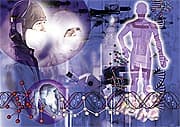Life Extension Magazine®
Ray Kurzweil has been receiving a lot of favorable publicity lately. If it were not for his impressive credentials, the media would have laughed off his predictions that humans will enjoy indefinite life spans in the near future. A long-time Life Extension member, Ray Kurzweil is an inventor whose work in artificial intelligence has dazzled technological sophisticates. He invented the flatbed scanner, the first true electric piano, and the first large-vocabulary speech-recognition software. He’s written five books and has 13 honorary doctorates.1,2 Ray predicts that in a few decades, we’ll have cell-sized robots circulating through our bloodstreams that will conquer pathological processes. Going beyond that, Ray states that future scientists will be able to upload a person’s consciousness into a computer—thus creating true physical immortality.2,3 It’s not just the media that has come to respect Ray Kurzweil’s optimistic view of the future. To pick up insights on the future of technology, Ray has been invited to Bill Gates’s house twice for dinner. In my last communication with Ray, I asked if he could try to persuade Bill Gates to change the purpose of his $50 billion charitable trust to finding a cure for aging. Bill Gates’s charitable trust will help solve third-world health problems that were eradicated in Western society long ago. While this is a noble purpose, it does nothing to combat the horrors faced by all of humanity as we slowly age to death. Interestingly, fellow mega-billionaire Larry Ellison (founder of Oracle Software) does commit substantial funding to scientists seeking to slow or reverse human aging (once pegged at $25 million/year).3 The Economist Predicts Biological Breakthroughs This CenturyOne of the world’s most authoritative news and technology magazines is The Economist. The stated aim of The Economist is to:
“…take part in a severe contest between intelligence, which presses forward, and an unworthy, timid ignorance obstructing our progress.”5 The Economist counts among its audience influential business and government decision-makers around the world. The lead editorial in a recent edition of The Economist was titled: “Biology’s Big Bang…What physics was to the 20th century, biology will be to the 21st”6 The editorial opened by providing a historical analogy relating to the discovery of the atom. Just a century ago, atoms were thought to comprise only protons and electrons, which created big gaps in explaining how physics really worked. When the neutron was discovered in 1932, this provided the critical missing link that enabled scientists to develop nuclear power a mere 13 years later. The editorial went on to state that biology is now undergoing its “neutron moment” in describing how new knowledge about RNA is enabling scientists to know exactly what is going on inside of cells (or to understand “the cell’s operating system” as they put it). Physics gave us the gift of the power over nature, which resulted in unprecedented advances in the 20th century ranging from automobiles and airplanes to computers and the internet. According to The Economist, genetic engineering is becoming routine and it points to the filing of the first patent of an “artificial living organism” as evidence that yesteryear’s science fiction is becoming today’s reality.
Stair Climbing Towards Biological ImmortalityWith each biological discovery, the human species climbs one step further towards gaining complete control over its own life processes. While recorded human history goes back about 10,000 years, the vast majority of scientific breakthroughs have only occurred over the past 100 years. For instance, it was not until 1953 that James Watson and Francis Crick identified the structure of DNA (for which they later won a Nobel Prize). Prior to 1953, it would have been difficult to conceive that doctors might one day control human cellular processes as easily as computer operating systems are now engineered. Of course back then, no one thought that computers would have ever advanced as far as they have already. While it took 10,000 years for humans to figure out the structure of DNA (1953), it only required a little over 50 years to map out the entire human genome! Genes are the cell’s “operating system,” enabling young healthy cells to function flawlessly. Gene expression is unfavorably altered as we age, which is what ultimately causes us to degenerate and eventually die. Research funded by Life Extension has identified specific genes that are adversely expressed as cells grow old. Life Extension researchers have discovered a readily available compound (grape seed extract with resveratrol) that favorably influences these changes so that genes are expressed in a more youthful pattern.7 Once scientists perfect methods to control gene expression, we believe it will be possible to “engineer” DNA so that our cells will be biologically immortal and completely resistant to cancer. So from 1953, we have gone from uncovering the basic structure of DNA all the way to developing sophisticated DNA gene expression assays. Life Extension scientists have used this technology to discover genes involved in aging and ways to partially control these pathological gene expression changes. Based on this rapid progress, more stairs have been climbed in the scientific discipline of cellular engineering over the past 54 years than what mankind accomplished in the prior 10,000 years. It is this velocity of advancement that is enabling renowned scientists to predict that biological immortality is not only a possibility, but one that could occur in the lifetimes of some of those reading this article now!
Breaking Down the Barriers of IgnorancePeople find it difficult to comprehend what has not happened yet. A radical concept that is slowly taking hold, however, is that future human life spans will not be time limited. Humans today find it difficult to grasp the idea of living much beyond 100 years in good health. Yet if one extrapolates the progress made in the physical sciences in the 20th century, achieving an indefinitely extended life does not seem far-fetched. Readers of this column span a wide range of generations, but most of us can remember a time when today’s computer technology would be considered impossible. Just imagine if you said in 1965 that there would someday be low-cost home computers that provided instant access to virtually every piece of data in the world often at no cost. If you gathered every expert in the world and asked them in 1965 if there was any conceivable way this technology could be developed, they would have written a 1000-page report to explain how this could never happen. People rely on computers for diverse purposes. I readily review hundreds of scientific papers a day on the exact topic I want by merely typing key words into my home computer. Gathering even a fraction of this information in the past would have required weeks spent in a medical library. I recently watched my 10-year-old son playing a sophisticated video game on his computer. At first I thought he was playing against the computer and then he told me he was actually playing against 20 other people. When I asked where these other people were, he sent a quick email out to one of the other players who instantly responded “China.” Even more amazing is that this sophisticated video game was being played for free!
I can tell you in 1965, a video game like this would have never been thought possible. If you were to have predicted that this video game could be played in simultaneous real time by players around the world at no cost, you would not have been believed. We at Life Extension have been stymied by pessimists for 27 years who say there will never be significant extensions in the healthy human life span. While arcane government regulations have severely repressed innovation in the medical field, I can tell you that it might only take one major breakthrough (such as perfection of genetic engineering) to enable humans to achieve youthful biological immortality. You could line up many critics of this prediction, but the inevitability that I see so clearly is that humans will discover technology that will eradicate all unwanted biological processes. As a member of the Life Extension Foundation, you belong to an elite group of forward-thinking individuals who have a clear vision of the marvels that will exist in that wonderful world of the future. For longer life,
William Faloon | ||||||||||||
| References | ||||||||||||
| 1. Available at: http://en.wikipedia.org/wiki/Ray_Kurzweil. Accessed July 30, 2007. 2. Available at: http://money.cnn.com/2007/05/01/magazines/fortune/kurzweil.fortune/index.htm. Accessed September 27, 2007. 3. Available at: http://www.afar.org/dinner-press-release.html. Accessed July 30, 2007. 4. Available at: http://www.time.com/time/magazine/article/0,9171,998691,00.html. Accessed August 1, 2007. 5. Available at: http://web.economist.com/opinion/. Accessed September 27, 2007. 6. Available at: http://www.economist.com/opinion/displaystory.cfm?story_id=9339752&CFID=16874167&CFTOKEN=60376734. Accessed August 1, 2007. 7. Available at: http://www.lifeextension.com/magazine/mag2007/may2007_report_lef_01.htm. Accessed August 1, 2007. 8. Available at: http://www.transhumanism.org/index.php/WTA/index/. Accessed September 27, 2007. 9. Bailey R. Would you give up your immortality to ensure the success of a posthuman world? Answering hard questions at the World Transhumanist conference. Reason Magazine. July 27, 2007. |





